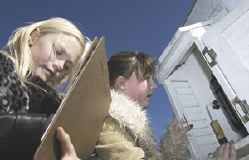Sixth-grade scientists
Norfork GLOBE students hit the mark
By MAGGIE ROTERMUND
Bulletin Staff Writer; maggier@baxterbulletin.com
|

|
Norfork sixth grade student Alyssa Parnell (right) takes
a number of weather-related readings Thursday while Brittany
Stocklas records the data. The students are participating in
the GLOBE Program, in which students from around the country
take daily weather measurements and enter them in a
database. The students recently recorded their 50,000th
measurement.
Photo by Kevin Pieper of the "Baxter
Bulletin" staff
|
NORFORK -- Each day students walk into Wade Geery's classroom, set
down their books and begin to work. Without being asked, they break
into small groups and scatter around the classroom collecting data
from the previous 24 hours and sending it to Boulder, Colo. The
information they collect is worth more than their grade. It is being
used by scientists around the world to study changes to the
environment.
These sixth-grade students at Norfork Elementary School reached a
milestone last week -- they recorded their 50,000th data point in
only four years of work. They are only the second school in the
country to reach this milestone, and that school no longer
participates in the program.
Geery's science classes use the GLOBE (Global Learning &
Observations to Benefit the Environment) program, which allows the
students to participate in real experiments by taking measurements,
analyzing data and working on scientific research. This year, the
students are collecting information on ozone levels, soil
characterization, hydrology, phenology, soil moisture and the
atmosphere.
"The first thing they do when they come in is check the weather
station," said Geery. "They take the data from the past 24 hours,
transfer it to the computer, format it and e-mail it off to UCAR."
UCAR is the University Corporation for Atmospheric Research.
At the beginning of each school year, Geery selects a few students
to train for each project. Those students then teach other students
and exchange jobs throughout the year.
Student Sarah Rodgers is in charge of riverflow. "I look at the
water release from the dams and its energy," Rodgers said. She
compiles her information into a database that provides the class with
a monthly report. "This is so much funner than my other classes," she
said. "You really see what we are learning."
From their data, students can draw a correlation between their
assumptions and what they find. "They are learning hands-on skills,"
Geery said. "This allows them to see relationships between any number
of things." Geery used the example of the river after a hard rain.
Students' data shows fluctuating levels of nitrates and chlorides.
Each day, the students take between 50 and 150 measurements. They do
individual tests, as well as check equipment that monitors around the
clock.
The program began in 1999. Sixth-graders that year collected 6,000
data points. That number doubledthe following year. In addition to
collecting the data, students also graph their results. Geery
believes these skills help with science testing. "If Arkansas begins
the Science Benchmark Exam in 2006 or 2007, I believe our students
will be well ahead and should see some high scores."
Some of the requirements of the GLOBE program include:
Taking scientifically valid measurements in the fields of
atmosphere, hydrology, soils and land cover/phenology.
Reporting their data through the Internet.
Creating maps and graphs on the free interactive Web site to
analyze data sets.
Collaborating with scientists and other GLOBE students around
the world.
There are 10,000 participating schools in the United States. The
GLOBE program now includes 102 countries.
Originally published in the "BAXTER BULLETIN" on Monday,
December 22, 2003.
